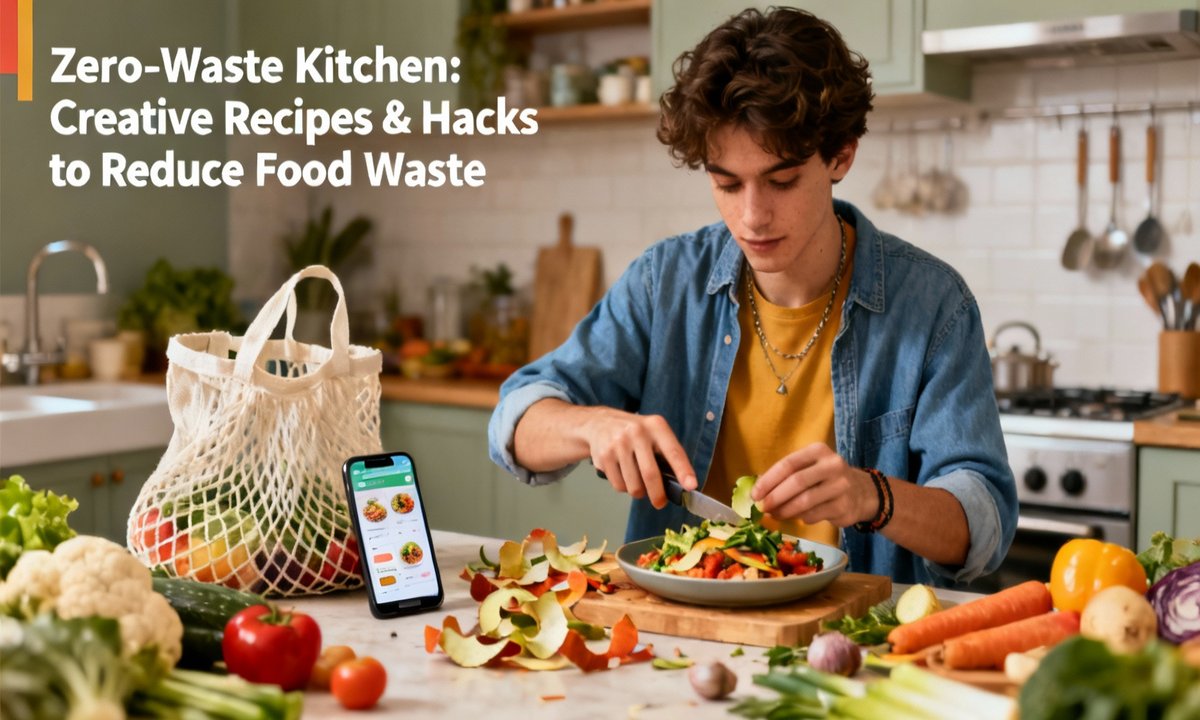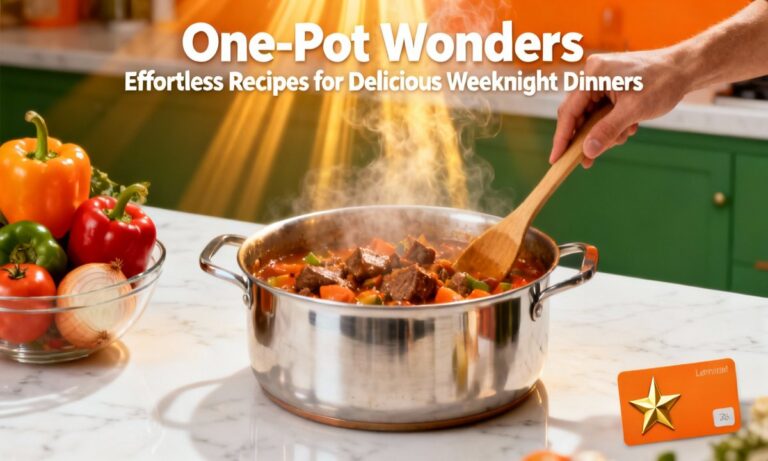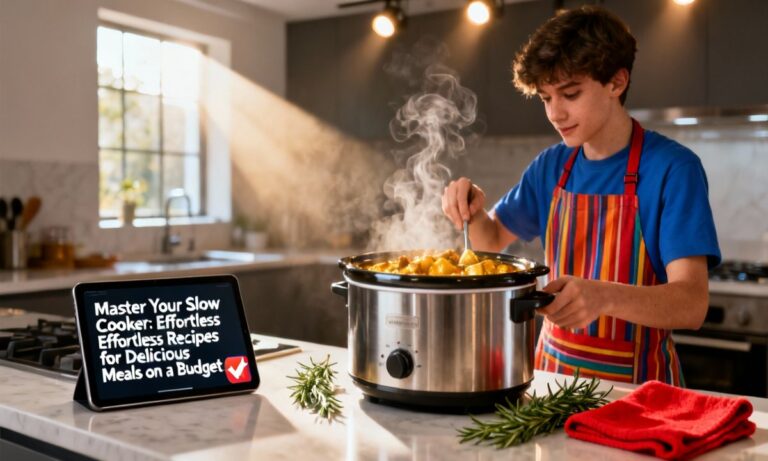Imagine a kitchen where every peel, stem, and leftover finds a creative purpose, transforming into something new and delicious. This vision is at the core of a zero-waste kitchen, a sustainable movement that is becoming increasingly popular across the United States. By significantly reducing food waste, you can save money, contribute positively to the planet, and unleash new culinary creativity in your home. Are you ready to embark on your own zero-waste journey? Let’s explore practical tips, innovative recipes, and essential tools for an eco-friendly kitchen that you will truly appreciate and love to use, promoting a conscious approach to cooking and consumption. Learn more about this initiative through [Move for Hunger](https://zerowastekitchen.moveforhunger.org).
Embracing a Zero-Waste Kitchen for a Sustainable Lifestyle
The Environmental and Economic Impact of Food Waste
Each year, a staggering 40% of food produced in America is wasted, ending up in landfills. This significant volume of waste contributes to the emission of methane, a potent greenhouse gas with severe environmental implications. Adopting zero-waste practices in your kitchen not only benefits the planet but also leads to substantial savings and more efficient resource utilization.
Reducing food waste at home can significantly lower your grocery expenses and decrease the frequency of shopping trips. It empowers your household to utilize every ingredient to its fullest potential, fostering a more sustainable daily routine. This small adjustment represents a powerful stride toward a more eco-conscious lifestyle. Discover more insights on reducing waste from the [EPA](https://www.epa.gov/recycle/reducing-wasted-food-home).
Societal Responsibility: Addressing Hunger and Waste
While over 38 million individuals in the U.S. grapple with food insecurity annually, a considerable amount of edible food is discarded. Embracing a zero-waste kitchen is therefore both an environmentally sound and ethically responsible decision. You’ll stretch your budget and make meals last longer, without necessarily increasing your spending. For further insights on frugal living, explore [pro tips on saving big at home](https://nvvbj.com/frugal-living-hacks-save-thousands).
Practical Hacks for a Waste-Free Kitchen
Smart Shopping and Storage Solutions
Strategic Grocery Planning
Embark on your zero-waste journey with mindful shopping habits. Utilize reusable bags, consider buying items in bulk, and select loose produce to reduce packaging waste. A carefully planned grocery list is crucial for preventing impulse purchases and minimizing future food waste. For more extensive meal planning concepts, explore [Healthy Eating on a Budget: Meal Prep Strategies for Affordable & Nutritious Meals](https://nvvbj.com/healthy-eating-budget-meal-prep-strategies).
Optimal Food Preservation
Effective food storage is paramount for extending shelf life. Invest in airtight containers, meticulously label your leftovers with dates, and promptly refrigerate perishable items to maintain their freshness. Reusable silicone freezer bags offer an excellent, sustainable alternative to disposable options, helping you minimize waste. Discover further preservation tips in our guide to [Essential Home Organization Tools](https://nvvbj.com/essential-home-organization-tools).
Innovative Cooking Approaches
From Root to Stem: Maximizing Ingredients
Resist the urge to discard parts like broccoli stems or beet greens! Many often-overlooked vegetable components are not only edible but also highly nutritious and flavorful. Experiment by incorporating cauliflower leaves into baked dishes or blending broccoli stems into creamy soups. To witness the potential of root-to-stem cooking, check out the creative recipes below.
Transforming Leftovers into New Meals
Give your dinner scraps a second life by repurposing them into tomorrow’s lunch or an entirely new dish. Overripe bananas are perfect for baking into delicious banana bread, while stale bread can be transformed into crispy, flavorful croutons. Make the most of every ingredient in your refrigerator for inventive, waste-conscious meals. Find inspiration for quick and easy recipes at [20-Minute Dinners: Delicious & Easy Weeknight Recipes for Busy Families](https://nvvbj.com/quick-weeknight-family-dinners).
Efficiency Through Batch Cooking and Freezing
Embrace the strategy of preparing larger portions and freezing them for later consumption. Batch cooking significantly reduces the likelihood of unused food, and having frozen meals readily available can be a true time-saver on hectic evenings. Opt for glass or silicone containers for freezing to further reduce your reliance on single-use plastics. Uncover more [budget-friendly cooking tricks](https://nvvbj.com/smart-grocery-shopping-cut-costs) to enhance your kitchen efficiency.
Composting: The Final Step in Waste Reduction
Simple Composting for Every Home
When food items are truly inedible, composting offers a responsible alternative to disposal. Items like eggshells, coffee grounds, and spoiled produce can enrich your garden soil instead of contributing to landfill waste. A discreet countertop compost bin can help maintain a tidy and eco-friendly kitchen environment. Our comprehensive guide, [Sustainable Home: Eco-Friendly Products for a Greener Living Space](https://nvvbj.com/sustainable-home-eco-friendly-products), provides detailed instructions to confidently begin your composting journey.
Beyond these core strategies, consider a few more ideas for a no-waste kitchen. Clearly label all leftovers to ensure timely consumption, prioritize recipes that utilize whole ingredients, and freeze chopped herbs or sauces in ice trays for future use. Donating surplus non-perishable items to local food banks is another excellent way to prevent waste and support your community.
Creative Culinary Ideas for Zero-Waste Meals
Recognize that your kitchen scraps hold immense culinary value! These zero-waste recipes are designed to help you maximize flavor while significantly minimizing food waste.
Delicious Dishes from Everyday Scraps
Spicy Baked Cauliflower Wings
Utilize both the florets and leaves of cauliflower for this exciting dish. Toss them generously with a spicy buffalo sauce, then bake until they achieve a perfect crispness. Serve alongside cool celery sticks for a delightful contrast. You’ll be amazed at how satisfying an entire vegetable can be. For more inspiration, find the [full recipe details here](https://www.bbcgoodfood.com/howto/guide/zero-waste-recipes-for-every-day).
Fridge-Raid Fried Rice
This incredibly versatile dish welcomes almost any leftover you have on hand – be it rice, slightly wilting vegetables, or even last night’s chicken. It’s a quick, satisfying, and completely waste-free option, making it an ideal weeknight meal solution. Discover similar time-saving [plant-based dinner ideas](https://nvvbj.com/30-minute-plant-based-dinners-easy-vegan-recipes) to spark your creativity.
Root-to-Stem Broccoli Soup
Never discard those robust broccoli stems again! Simmer them along with the florets, garlic, onions, and your favorite broth. Blend the mixture to create a creamy, nutrient-packed soup that truly utilizes every part of the vegetable. This approach embodies the essence of [sustainable cooking](https://nvvbj.com/sustainable-home-eco-friendly-products). Find more inspiration at [Going Zero Waste](https://www.goingzerowaste.com/blog/my-favorite-sustainable-recipes-to-reduce-food-waste/).
Revitalized Banana Bread
Give your overripe bananas a delicious second chance by transforming them into moist and flavorful banana bread. This versatile bake is perfect as a snack, a breakfast treat, or a delightful dessert. Opting for whole grain flours can further boost its nutritional value while maintaining a low-waste profile.
Homemade Stale Bread Croutons
Instead of tossing the ends of your bread, cube them, toss with a touch of oil and your preferred herbs, then bake until golden and crunchy. These homemade croutons are a fantastic addition to soups and salads, showcasing creative reuse at its most delicious.
Nutritious Vegetable Scrap Stock
Begin collecting onion skins, carrot tops, celery leaves, and other suitable vegetable scraps in a freezer bag. Once full, simmer these collected scraps to create a rich, flavorful vegetable stock, ideal for enhancing soups and sauces. This classic food scrap recipe is a staple for a waste-conscious kitchen. Learn more from the [Zero-Waste Chef](https://zerowastechef.com).
Refreshing Fruit Peel Infused Water
Elevate your hydration by adding discarded fruit peels, such as orange peels, apple cores, or strawberry tops, to water along with a sprig of fresh mint. This simple hack creates a naturally refreshing and flavorful beverage that is beneficial for both you and the environment.
Hearty Carrot Bean Stew with Carrot Leaves
Did you know carrot leaves are incredibly nutrient-dense? Incorporate them into a cozy, zero-waste dinner alongside carrot roots, beans, onions, and garlic. This stew offers a comforting and complete meal. For additional inspiration, check out [Imagine5](https://imagine5.com/articles/no-leaf-left-behind-delicious-zero-waste-recipes/).
Savory Zero-Waste Cauliflower Blinis
Maximize your cauliflower by grating the stem—yes, the stem!—and roasting the leaves. This combination can be used to prepare savory blinis or stir-fried with your favorite spices for a unique side dish. Explore more global-inspired ideas in our [global budget cuisine guide](https://nvvbj.com/global-flavors-local-budget-recipes).
Essential Tools for Your Zero-Waste Kitchen
Sustainable Storage and Prep Essentials
Durable Reusable Containers
Choose glass or BPA-free containers in a variety of sizes, perfect for storing leftovers, preparing lunches, and organizing freezer contents. Their airtight seals are crucial for keeping food fresher for extended periods and significantly reducing your dependence on single-use plastics.
Versatile Silicone Freezer Bags
These durable and washable silicone bags are a popular choice for zero-waste enthusiasts. They are ideal for freezing leftover meals, organizing snacks, or marinating proteins. Their reusability makes them a far more sustainable option compared to disposable plastic bags.
Convenient Compost Bins
Integrating a small indoor compost bin can revolutionize your eco-friendly kitchen practices. Complement it with a larger outdoor composting system or a local community drop-off site to effectively divert food scraps from landfills.
Eco-Friendly Beeswax Wraps & Cloth Covers
Replace traditional plastic wrap with reusable beeswax wraps or attractive fabric bowl covers. These sustainable alternatives are excellent for preserving half-used vegetables or covering dishes with leftovers, enhancing your kitchen’s ecological footprint.
High-Quality Knives & Graters
Investing in sharp knives and efficient graters is fundamental for maximizing the use of every edible part of your produce. These tools enable you to expertly zest citrus peels or precisely slice roots and stems for various culinary creations, such as stir-fries.
Keep abreast of additional [eco-friendly kitchen finds](https://nvvbj.com/sustainable-home-eco-friendly-products) to continuously enhance your sustainable living practices.
Common Questions About Zero-Waste Kitchens
Addressing Safety and Family Involvement
Are zero-waste kitchen practices safe?
Absolutely! It is crucial to always use food-safe containers, pay close attention to best-by dates, and only compost items that are genuinely inedible or spoiled. Reusing safe leftovers is a highly recommended practice. In any situation where you are unsure, rely on your senses and consult official food safety guidelines from the FDA.
How can families or children get involved in a zero-waste kitchen?
Encourage younger family members to participate by helping with meal planning, assisting with proper food storage, or getting creative with snacks made from leftovers. Projects like baking banana bread or making homemade croutons can be engaging family activities that are both fun and educational, while effectively reducing waste.
Debunking Myths and Easing into Composting
I am new to composting; how should I begin?
A great starting point is a small countertop bin for collecting items like fruit peels and coffee grounds. Once full, transfer these materials to a larger outdoor compost pile or a local community drop-off facility. Our [eco-cleaning kit guide](https://nvvbj.com/eco-friendly-cleaning-kit-guide) offers valuable tips for establishing a non-toxic and odor-free composting area in your home.
Is adopting a zero-waste lifestyle in the kitchen expensive or difficult?
Contrary to common misconceptions, a zero-waste kitchen often leads to financial savings and can simplify your daily routine! Begin with straightforward changes, such as using reusable shopping bags, and gradually incorporate new habits. For busy households, embracing batch cooking and strategic meal planning are practical and effective initial steps.
What are some of the biggest myths surrounding zero-waste kitchens?
One prevalent myth is that you need elaborate gadgets or must prepare every meal entirely from scratch. In reality, a zero-waste approach emphasizes using what you already possess—creatively, consistently, and with conscious awareness to minimize waste and maximize resources.
Additional Resources for Your Zero-Waste Journey
For those keen to delve deeper into the principles and practices of a zero-waste kitchen, several valuable resources are available. Explore comprehensive guides from [Zero Waste Kitchen – Move for Hunger](https://zerowastekitchen.moveforhunger.org) and review the insightful [Zero-Waste Kitchen Companion from UCLA (PDF)](https://www.sustain.ucla.edu/wp-content/uploads/2021/10/Zero-Waste-Kitchen-Companion-Final.pdf) for detailed information. Additionally, the [Zero-Waste Chef Blog](https://zerowastechef.com) offers a wealth of practical tips and creative recipes.
If you are seeking further practical advice on seasonal ingredients or budget-friendly meal ideas, we encourage you to explore our comprehensive guide to [Seasonal Eating on a Shoestring](https://nvvbj.com/seasonal-eating-budget-recipes). This resource can help you maximize savings while effectively minimizing waste in your culinary endeavors.
Join the Movement: Start Your Zero-Waste Kitchen Today!
Your journey toward a zero-waste kitchen begins with a series of mindful, incremental steps. This involves rethinking your approaches to shopping, food storage, cooking, and composting. Each conscious action contributes significantly to saving food, reducing expenses, and conserving valuable resources, thereby transforming your household into a beacon of eco-friendly living. We invite you to try just one new hack or recipe today. Feel free to share your personal tips in the comments section below or submit your favorite waste-busting strategy for a chance to be featured on our platform! Together, we can inspire more individuals across America to embrace sustainable cooking practices.
Are you eager for more innovative smart home ideas, wholesome recipes, or inspiration for sustainable living? Delve into our extensive collection of [DIY home guides](https://nvvbj.com/budget-friendly-diy-decor-ideas-every-room-2), discover invaluable [meal planning tips](https://nvvbj.com/healthy-eating-budget-meal-prep-strategies), or explore possibilities for [advanced smart home upgrades](https://nvvbj.com/advanced-smart-home-energy-efficiency). Remember, your zero-waste kitchen is merely the starting point—let’s collectively strive to make every area within your home greener and more energy-efficient.





